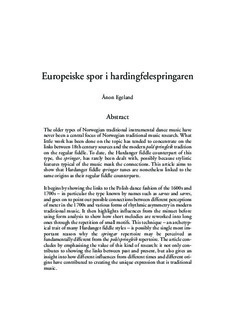Europeiske spor i hardingfelespringaren
Journal article, Peer reviewed
Published version
Permanent lenke
http://hdl.handle.net/11250/2447863Utgivelsesdato
2016Metadata
Vis full innførselSamlinger
Originalversjon
Musikk og tradisjon. 2016, 30, 31-54.Sammendrag
The older types of Norwegian traditional instrumental dance music have never been a central focus of Norwegian traditional music research. What little work has been done on the topic has tended to concentrate on the links between 18th century sources and the modern pols/springleik tradition on the regular fiddle. To date, the Hardanger fiddle counterpart of this type, the springar, has rarely been dealt with, possibly because stylistic features typical of the music mask the connections. This article aims to show that Hardanger fiddle springar tunes are nonetheless linked to the same origins as their regular fiddle counterparts. It begins by showing the links to the Polish dance fashion of the 1600s and 1700s – in particular the type known by names such as sarras and sarres, and goes on to point out possible connections between different perceptions of meter in the 1700s and various forms of rhythmic asymmetry in modern traditional music. It then highlights influences from the minuet before using form analysis to show how short melodies are reworked into long ones through the repetition of small motifs. This technique – an archetypical trait of many Hardanger fiddle styles – is possibly the single most important reason why the springar repertoire may be perceived as funda mentally different from the pols/springleik repertoire. The article concludes by emphasising the value of this kind of research: it not only contributes to showing the links between past and present, but also gives an insight into how different influences from different times and different origins have contributed to creating the unique expression that is traditional music.
